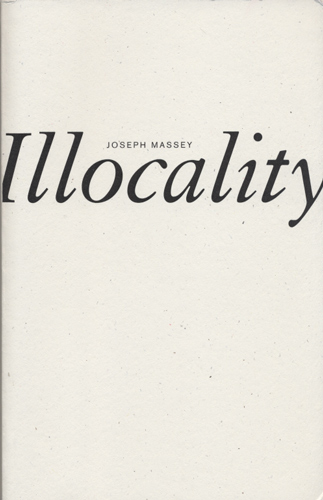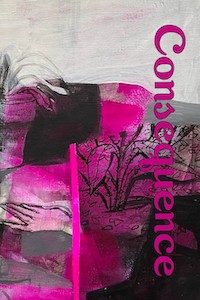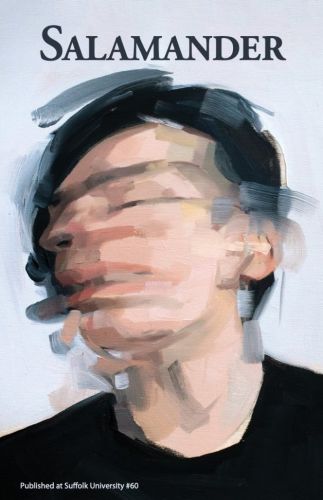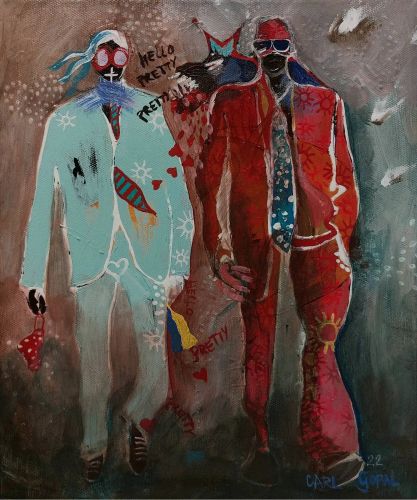Joseph Massey mentions in the refreshingly spare notes of his fourth collection Illocality that he first encountered his title word in the Emily Dickinson poem “A nearness to Tremendousness.” Dickinson is an apt predecessor for a poet of such deliberate cerebralness. Yet, for his fine command of image, so is William Carlos Williams, or any number of Asian short-form poets. Indeed it is the relationship between logic and image, mind and world, that drives these poems so evenly through their inquiries, that most characterizes their productive tensions. “We think / ourselves here,” Massey writes to close the opening poem “Parse.” Joseph Massey mentions in the refreshingly spare notes of his fourth collection Illocality that he first encountered his title word in the Emily Dickinson poem “A nearness to Tremendousness.” Dickinson is an apt predecessor for a poet of such deliberate cerebralness. Yet, for his fine command of image, so is William Carlos Williams, or any number of Asian short-form poets. Indeed it is the relationship between logic and image, mind and world, that drives these poems so evenly through their inquiries, that most characterizes their productive tensions. “We think / ourselves here,” Massey writes to close the opening poem “Parse.”
These are unimaginably quiet pieces (organized according to season), at times delicate, slow of pace, blinking in a kind of half-consciousness as the world proffers its objects one-by-one. Massey’s world is, for lack of a better term, very real, populated by the litter of the visual plane that only the most acute poets can isolate and lend size to. We are often in the backyard, among debris, failing plants, scavenging creatures, and the general grit of untended or impoverished environments. And it’s all cast in great varieties of light, which charge these objects with, if not some deep meaning, at least a kind of volition. Take, for example, these stanzas from “A Title for the Haze”:
In a patch of sunlight
a decapitated grasshopper
twitches. The sunlight twitches.
Sky the size of a sky imagined.Squint to see the quarter moon
—shallow gash on blue horizon.
Squint to hear beyond windows
wafting muzak. I’m half-awakein this field of turned-on particulars.
I quote this progression, also, because it so thoroughly develops one of Massey’s primary obsessions, which I can only clumsily describe as the absence of mind as a kind of mind itself. The grasshopper is “decapitated,” yet it moves, and not only that, but its movement is tuned to that of the sunlight. It is this mindlessness, this “half-awake” state, that “turns on” the world, that bridges that most unbridgeable gap between imagination and reality, the “sky the size of a sky imagined.”
Massey is quite direct about this sort of stuff in numerous places. In “Turned” we have “the eye / without a thought // threads the sky through.” In “To Surface” we have “with a word / in mind // and then another // with the mind set aside.” And in the wonderful long poem “Take Place,” we get this variation as the closing couplet: “The world is real / in its absence of a world.” This notion of mind and world absentia and erasure is critically generative, and in many of the opening poems its logical play, its paradox and impossibility, forms the substructures atop which Massey’s spare but affecting visual drapery lays—which is to say, they are what he is driving at, what he is meditating, visually, toward. Let me quote “Greenfield,” which is a fine example of this movement:
Neon sex-shop sign
levitates within brick.Cloud ridge
brims purple
over shadow-
flattened mountain.
A transienttrips through
a fog of gnatsunder a streetlamp [ . . . ]
From the center
of the inexplicablenight branches out.
The poems in the first half of the collection often have these kinds of end-caps, a calculated result or metaphysical summary of the extant world. This begins to change, subtly, as we move through the middle section and into the winter and spring poems. It’s not an absolute development, but the book begins to get inhabited by more sonically driven and imagistically compressed pieces. The long poem “Thaw Compass” contains, perhaps ironically, a lot of these hard-packed moments, such as:
March rain snow thaw
crumpled metal sign stuck
gravel-grained mud mulch
ground to dust over sidewalk divots
The effect is a narrative arc, a poet who starts to work into a frenzy. At once the pace of the poems quickens as the focus also seems to concentrate, like the throbbing pulse of deep meditation, beads of sweat on the brow. Massey breaks through, it seems, to the other side, so by the time we reach the title poem—which is penultimate—we have returned to this relaxed pace and unfolding:
To imagine a morning
the first
sounds from the streetand the house, its halls
scarifying
consciousness
The progression lends a subtle but lovely sense of relief, a sense of awakening. We are still with this poet of arresting meditative quiet, but now we feel a little more exercised, more nimble. And the entire journey seems to take place in the space and time of a single breath.
Altogether, Illocality offers expertly executed poems that stitch scene to thought in a way that gives body to the voice of the poet, that imbues the occasions and locations of the poems with a very physical sense of consciousness, one working, line-by-line, to understand, to be a part of the world. These are austere poems in their feel, but they are rich in maneuvers, and their meditations leave the reader in a deeply satisfied, mindfully mindless, state.





